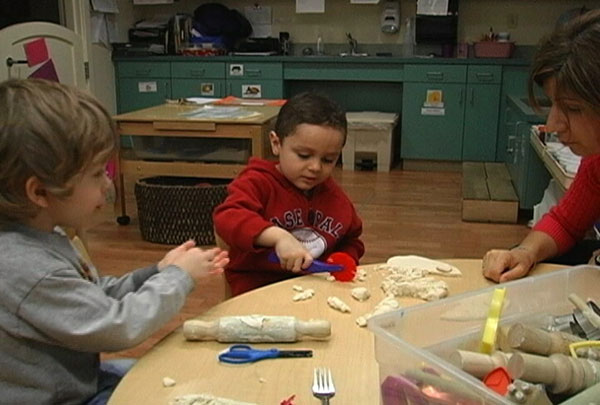Video Transcript for Supporting Children's Individual Needs
Dr. Jeffrey Trawick-Smith, Host: Children enter preschool at differing levels of development. Preschool professionals use many sources of information to determine whether a child needs specific types of support. Dr. Ann Gruenberg, an expert in early childhood special education, suggests ways that early education professionals can design strategies and collaborate with families to support the individual child’s needs.
Dr. Ann Gruenberg, Expert: We know that early childhood is a really crucial time for children in general. Because we think of development as a dynamic process and we know in young children, the central nervous system development continues on during the first few years of life. So they’re very, very responsive to environmental changes or environmental factors.
Voiceover: When Javier first came to Niloufar Rezai’s class, his parents wanted to make sure that his individual needs were met.
Mother: He came here about 3, 3½ years old. So I was a little nervous, because I thought he was little. We really wanted him to be able to learn.
Father: We felt that he would learn a lot more if he were exposed to other kids. And maybe that was a better learning tool for him.
Niloufar Rezai, Teacher: We want all children who enter our early childhood classroom to have “access, participation, and support,” and by that I mean we want them to have access to materials and experiences, be able to participate in any way that they are developmentally ready to participate, and we have to be ready to provide supports as needed to ensure that children have the opportunity to participate.
Niloufar: Each child when they enter our classroom enters initially with us having some background information on them. So we start by having met their families—getting to know what their family is like, and what their interests are.
Father: He has a lot of interest in games…He learns a game very fast. He gets really comfortable.
Niloufar: Speaking to the families and learning about a child’s interests at home is so important, because it gives you an opportunity to build on that interest and have a conversation about it at school.
Dr. Gruenberg: Assessment is a really important aspect of providing appropriate intervention for children when they are very young, because we need to identify their characteristics.
Niloufar: We observe daily throughout the different parts of the day… We take anecdotal records, there’s photographs, there’s child samples, work samples, video samples.
Dr. Gruenberg: We’re looking at their patterns of strength, we’re looking for patterns of need, and then we’re identifying adaptations that might be effective.
Niloufar: It’s really important to include all the members of the team that are working with the child so that we can pick up as much information as possible. And also speaking to families and asking them questions: "This is what I'm seeing at school; what are you noticing at home?" And that kind of gives you another piece of assessment information.
Father: She always takes the time to talk to me when I drop him off in the morning and just give me an update on how he did the previous day. Just to let me know what they’re doing through the day, as the day goes on.
Niloufar: Each week when I fill out my individual child plans, I look at each child and I think, “Ok, what were some of the strengths I saw this week, and what would I like to work on?
Voiceover: After observing Javier and talking with his parents, Niloufar wanted to ensure that Javier had plenty of opportunities to develop his oral language skills. One strategy she used was encouraging peer interaction.
Niloufar: At the play-dough table, the materials are open-ended enough that Javier and his friend Dominic can engage in play together. And I can be there to facilitate, asking questions at different levels so they can both be participating in the same conversation, yet at their own pace.
Voiceover: Niloufar also gave Javier’s parents some ideas for things they could do at home to support his language development.
Father: Reading a book at night before he goes to bed, that's something that Ms. Nil brought and it's been very helpful; Javie enjoys that a lot. We play the characters in the book and we all take turns reading him a book each night.
Mother: We collaborate at home with the ideas that Ms. Niloufar has given us, and we’ve always sat down together and we talk about it as a family: how we can make little Javie’s experience better. Being the littlest one in the house, you do get lost and everyone being so big and talking for you. So as time has gone by he has, “Excuse me,” and “I have something to say.” “I have a question,” which is very important, which we didn’t teach him but he’s learned to have a voice in school and he brought that home.
Dr. Gruenberg: In terms of giving advice to new teachers and professionals: I think teamwork is absolutely essential. Problem solving is absolutely essential. Understand that no one has all the answers to all the questions, and its okay to ask for help. So being willing to work with others, being willing to accept feedback and most definitely being willing to work with families in very constructive ways.
Father: Javie has shown a lot of improvement in the past few months—I would say understanding, comprehending more, talking. So I think he's getting to the level that he should be.
DEC/NAEYC. (2009). Early childhood inclusion: A joint position statement of the Division for Early Childhood (DEC) and the National Association for the Education of Young Children (NAEYC). Chapel Hill: The University of North Carolina, FPG Child Development Institute.



